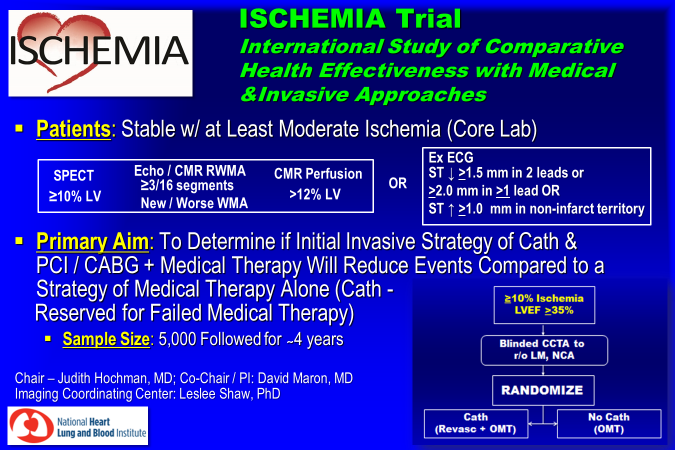An Update on the ISCHEMIA Trial
Over the past 5 years, the National Institutes of Health and National Heart, Lung, and Blood Institute sponsored ISCHEMIA (International Study of Comparative Health Effectiveness With Medical and Invasive Approaches) has been actively enrolling patients with stable ischemic heart disease (SIHD) at more than 300 centers around the world (including 40 countries). This randomized trial is nearing its final years of recruitment, and this update provides readers with insight into the trial design and the potential for this large randomized trial to impact care of patients with SIHD. As readers of this website are aware, prior SIHD trials did not demonstrate improved clinical outcomes associated with a strategy of percutaneous coronary intervention (PCI) with optimal medical therapy compared with optimal medical therapy alone. The primary conclusion from prior SIHD trials was that an index strategy of optimal medical therapy alone was safe and equally effective as PCI with optimal medical therapy. These findings had far reaching implications for the practice of prompt PCI following the diagnostic evaluation and identification of patients with obstructive coronary artery disease (CAD) suitable for revascularization and without significant left main disease.
Yet, there are limitations from prior trials that are worthy of discussion. Importantly, nearly 60% of patients enrolled in the VA-sponsored COURAGE (Clinical Outcomes Using Revascularization and Aggressive Drug Evaluation) trial had either no ischemia or very mild ischemia on provocative testing. From the COURAGE trial, ischemia eligibility criteria included new resting ST-T wave changes, ≥1 mm exertional ST segment changes, or ≥1 ischemic imaging defect. Enrollment was also permitted for patients with angina and ≥70% stenosis without any stress test requirement. These criteria can be criticized considering that electrocardiographic changes and small amounts of ischemia are suboptimal in predicting event risk and obstructive CAD severity. It may be speculated that enriching this population with more severe ischemia could have led to varying trial results. In a substudy within the COURAGE trial, serial nuclear imaging at baseline and 1-year post-randomization revealed that PCI with optimal medical therapy led to greater ischemia reductions compared with optimal medical therapy alone. However, there was no difference in outcomes by randomized treatment assignment regardless of the severity of ischemia, based on site interpretation.
In 2012, ISCHEMIA began enrollment and set the stage for a more advanced and updated SIHD trial. The trial design of ISCHEMIA is unique in that the recruitment of 5,000 patients with SIHD is limited to those with moderate-severe ischemia. Moreover, unlike prior SIHD trials, ischemia eligibility is not limited to stress nuclear imaging. ISCHEMIA eligibility includes moderate-severe ischemia on stress echocardiography or magnetic resonance (MR) imaging. Additionally, a patient may meet trial eligibility based on moderate-severe ischemia by exercise electrocardiography (without imaging). During trial design, leaders in the field of stress imaging had to identify the means to quantify moderate ischemia for the different modalities. Instead of expert opinion, the lead imaging investigators decided to define moderate ischemia based on comparable major coronary disease event rates; in this case, it was ~5% per year. From the prognostic literature and validated in external patient databases, this corresponds to ≥10% ischemic myocardium on stress nuclear, ≥3/16 segments with worsening wall motion abnormalities on stress echocardiography or MR, and >12% ischemic myocardium for a stress MR perfusion study.
Moreover, an additional fascinating twist in the trial design is that blinded coronary computed tomography angiography (CTA) is performed to exclude patients with no obstructive stenosis or significant left main stenosis and to confirm the presence of obstructive CAD. Thus, for all purposes, enrollment of patients with a sizeable burden of ischemia is based on the knowledge that they have obstructive coronary disease but without specific anatomic information on location or severity except for absent left main disease. CTA is not performed in patients with estimated glomerular filtration rate <60 ml/min or recently defined coronary anatomy. Eligible patients are then randomized to a strategy of coronary angiography and complete revascularization (invasive strategy) or a strategy of optimal medical therapy with coronary angiography and revascularization reserved for optimal medical therapy failure. Consistent with current SIHD guidelines, prompt optimal medical therapy is initiated in both randomized arms of ISCHEMIA. The ISCHEMIA randomization scheme is detailed in Figure 1.
Figure 1
To date, more than 4,300 patients have been randomized in the ISCHEMIA trial. We believe that this landmark trial offers huge opportunities for imaging to be a core component and decision trigger for SIHD clinical management. This trial will have tremendous implications regarding the use of ischemia testing and coronary CTA in clinical management of SIHD and may potentially alter the current evaluation strategy. We look forward to completing this trial and presenting the exciting findings from ISCHEMIA in the next few years.
References
- Shaw LJ, Berman DS, Picard MH, et al. Comparative definitions for moderate-severe ischemia in stress nuclear, echocardiography, and magnetic resonance imaging. JACC Cardiovasc Imaging 2014;7:593-604.
- Shaw LJ, Weintraub WS, Maron DJ, et al. Baseline stress myocardial perfusion imaging results and outcomes in patients with stable ischemic heart disease randomized to optimal medical therapy with or without percutaneous coronary intervention. Am Heart J 2012;164:243-50.
- Phillips LM, Hachamovitch R, Berman DS, et al. Lessons learned from MPI and physiologic testing in randomized trials of stable ischemic heart disease: COURAGE, BARI 2D, FAME, and ISCHEMIA. J Nucl Cardiol 2013;20:969-75.
- Shaw LJ, Cerqueira MD, Brooks MM, et al. Impact of left ventricular function and the extent of ischemia and scar by stress myocardial perfusion imaging on prognosis and therapeutic risk reduction in diabetic patients with coronary artery disease: results from the Bypass Angioplasty Revascularization Investigation 2 Diabetes (BARI 2D) trial. J Nucl Cardiol 2012;19:658-69.
Keywords: Coronary Artery Disease, Coronary Angiography, Echocardiography, Stress, Exercise Test, Constriction, Pathologic, Drug Evaluation, Angiography, Glomerular Filtration Rate, Myocardial Ischemia, Percutaneous Coronary Intervention, Angina Pectoris, Electrocardiography, Magnetic Resonance Spectroscopy, Myocardium, Diagnostic Imaging, Angina, Stable
< Back to Listings

